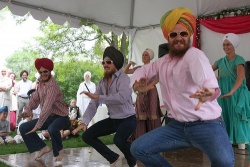Talk:Sri Guru Granth Sahib on dance
These traditions are not encouraged and supported by Sikhi and Gurbani. Many provide Gurbani quotes that make reference to dancing and claim that dancing is accetable provided that it is used as a positive, communal and constructive function for unity and celebration of society. They also claim that dancing has negative outcomes when used to escalate ones ego or pride; or for self-excitation; or for sensual gratification, these same activities are condemned by the Guru. However, such analysis of Gurbani is superficial at best and avoids the deeper connotations of the Guru's Word, which is limitless in its depth.
......
The first question that must arise when the above verse is mentioned is whether there is a single historical text that supports the Gurus or the Sikhs ever dancing? No references can be found of the Gurus or their Sikhs ever engaging or being encouraged to dance. But further study of more Gurbani will clear up what the "dancing" being referred to is. Ask yourself, can you see Guru Nanak Dev Sahib or Guru Gobind Singh Ji, or the Punj Pyare dancing? If not, then why would the student (Sikh) engage in activities that the teacher (Guru) would not? The teacher sets the example for the student, and the perfect student is the very image of the teacher.
..... Do Bhangra/Giddha/Hip Hop/R&B/Bollywood songs and the accompanying dance allow one to embrace the Lord? Is the dance being mentioned that of the worldly or spiritual? Have there been references made in Sikh history, or any other history for that matter, that proclaim that the ego has been shed through dancing? Or is the dance being referenced in this verse of another nature?
..... Again, the above questions must be asked. If dancing from this verse is taken literally to mean the worldly act of dancing, who has played the instrument of intellect, the tambourine of love? Analogies, metaphors and similies are aplenty in Gurbani, that associate worldly activies to the reader to allow for a spiritual awakening through explanation in simple terms. Are such things to be taken literally? If so, then one must also be able to fulfill the conditions set in Gurbani. The above verse for instance, states that dancing would impart bliss and lasting pleasure. Have the worldly dancers achieved this?
....
This verse is in the similar vein of the above verse, where the "dance" mentioned is actually to develop unrelenting love for the Almighty. Devotional worship, in which one develops love, longing and a deep desire to meet the Almighty is the dance being alluded to in the verses. One must again query whether Bhangra or Giddha or Salsa dancing impart such high spiritual states.
....
Is the "dance" being referred to here a worldly dance, or that of the entire play of the world being acted out on the universe-stage? "Dancing" here is referring to the constant happenings of the universe. The very being, the existence of the world, is "dancing" to the Almighty's Will. There is no justification being provided to engage in worldly dancing.
....
This verse actually tells of how people are deluded in the worldly stage, with dancing being given as a means for a woman to entice onlookers, and will one day perish to the ultimate reality of Death. Guru Sahib is actually telling the reader to awaken from their slumber of the 5 vices and to realize that Death is ever close.
..... Indeed, Guru Sahib's path never encouraged the recluse lifestyle. The gristi (householder) lifestyle was encouraged and accepted. The activities described in the above verse are a testament to that, where Guru Sahis is preaching to the reader that the Gursikh will be able to attain liberation while engaged being a part of it, not only as a tyagi (he/she who has abandoned the world). A Sikh must embody the concept of tyagi of tyag - one who has no attachments in the world and yet is able to participate in it. As a lotus that sits on the world ocean, the Sikh is rooted in the world, and yet above it (mentally and spiritually one with the Almighty).
.....
Therefore, Gurbani has not given Sikhs a green light to dance their lives away. Even if a very liberal view of dancing was to be accepted, one must always remember that any activity that a Sikh undertakes is to be in constant meditation of the Almighty and to reach ever closer to that One-Supreme. All other activities are useless per Gurbani.

